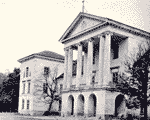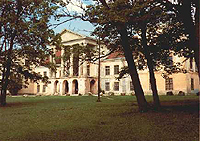


Kolga, Estonia
Throughout the seventeenth century the Stenbock family acquired vast tracts of land in Sweden, Estonia and Russia. Chief among these was the land at Kolga where they bought mansion belonging to Pontus de la Gardie, a favourite general of the Swedish King.
The Stenbock's fortune was built on vodka and advantageous marriage. One member, Katherine, had married the famous Swedish king Gustav Wasa and held positions of power in courts across Scandinavia. In spite of their aristocratic connections the Stenbocks were known as compassionate and fair landowners who, even though society was very feudal were genuinely liked by their peasant farmers.
 The
mansion at Kolga was substantially rebuilt in 1765 and
enlarged to be a property befitting the family's status in the country.
Little changes the house is still a three storied structure with a
balcony above a portico and Corinthian pillars surmounted by the Stenbock
crest.
The
mansion at Kolga was substantially rebuilt in 1765 and
enlarged to be a property befitting the family's status in the country.
Little changes the house is still a three storied structure with a
balcony above a portico and Corinthian pillars surmounted by the Stenbock
crest.
The Stenbock's also owned a summer house at Zitter a few miles away on the Estonian coast. This was a summerhouse in the Scandinavian style, less formal than the main family home but no less substantial.
While Eric was a child the house at Kolga was owned by his father but on the older Stenbock's death it was passes back to his grandfather, Magnus, who held it for the child. Always a superstitious family, the Stenbock's believed the house was haunted and that a mysterious white lady appeared on New Year's Day. They also believed that the image of a family member would appear at a window at the moment of their death. A number of people claimed to have seen Eric's face at the window in 1895 before the family knew he was dead.
During the early twentieth century, Estonia moved from being a Russian dominated society to one much more concerned with national identity. Tallin became an important industrial centre and by 1919 they had broken away enough for an independent parliament to be formed. After a short war of independence Estonia gained its freedom from Russia. Aware of the old divisions the new government instituted land reforms, removing large estates from the aristocrats and dividing them amongst farming co-operatives. The Stenbock's, however, held their house and position until the arrival of the Soviet army in 1940.
Estonia was occupied by the Soviets between 1940 and 1991. All perceived aristocrats lost their land and the country became a communist sub state of the Soviet Union.
 Now
that Estonia has regained its independence the mansion has been returned
to
the Stenbock family. Unfortunately the building needs huge restoration
because of the fifty years of neglect but the
Stenbock's
are running a hotel and restaurant in
the mansion, and gradually trying to restore main building.
Now
that Estonia has regained its independence the mansion has been returned
to
the Stenbock family. Unfortunately the building needs huge restoration
because of the fifty years of neglect but the
Stenbock's
are running a hotel and restaurant in
the mansion, and gradually trying to restore main building.



